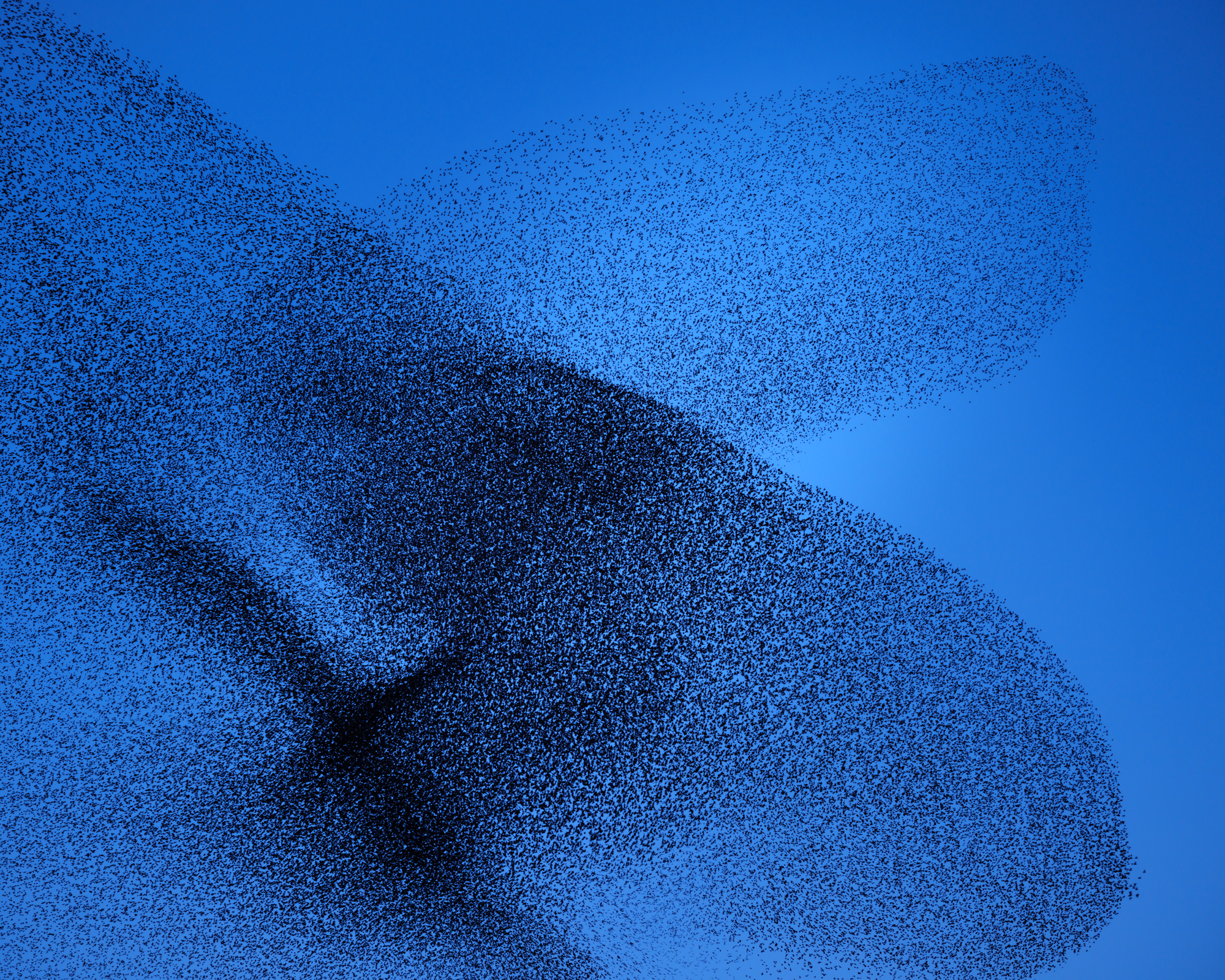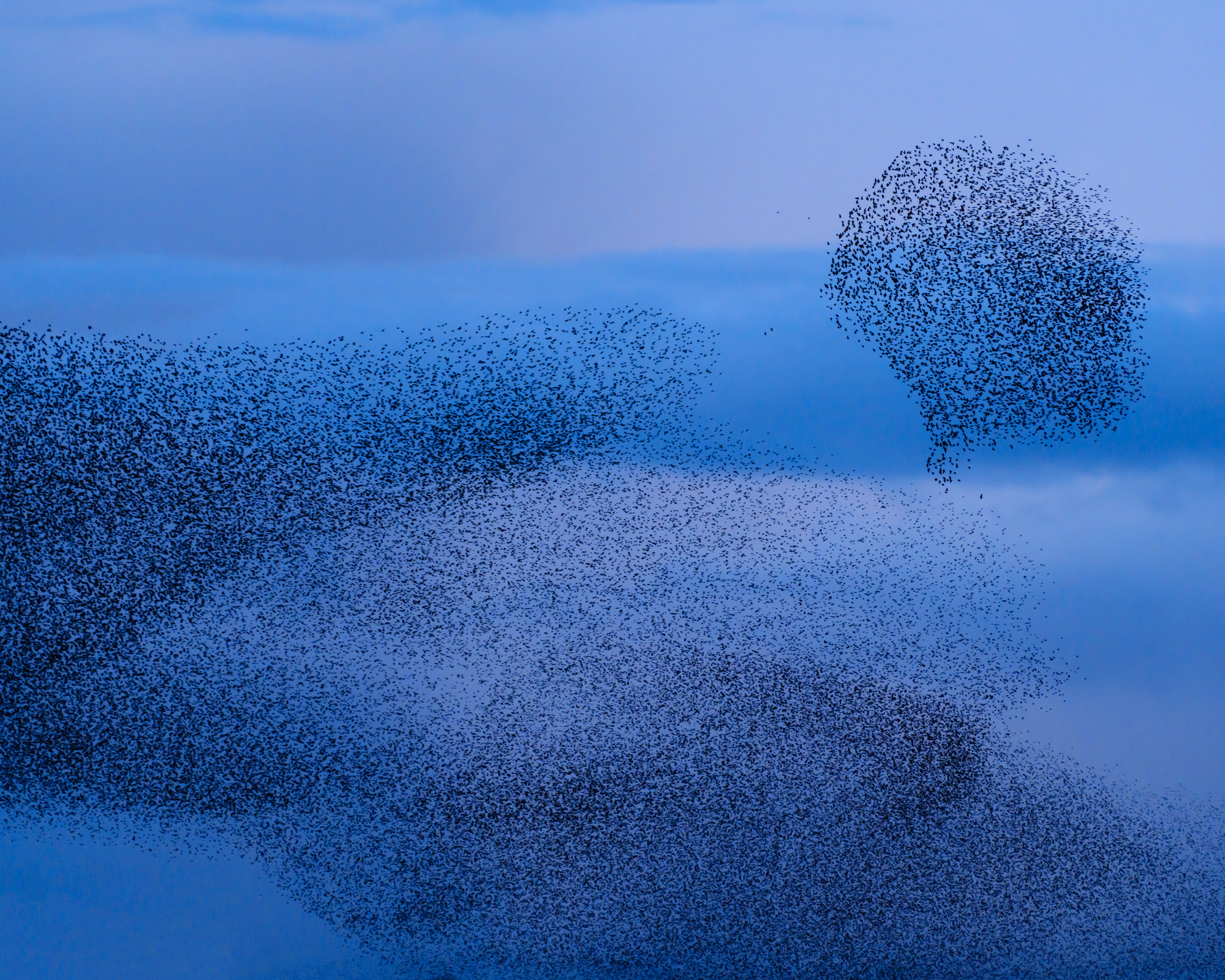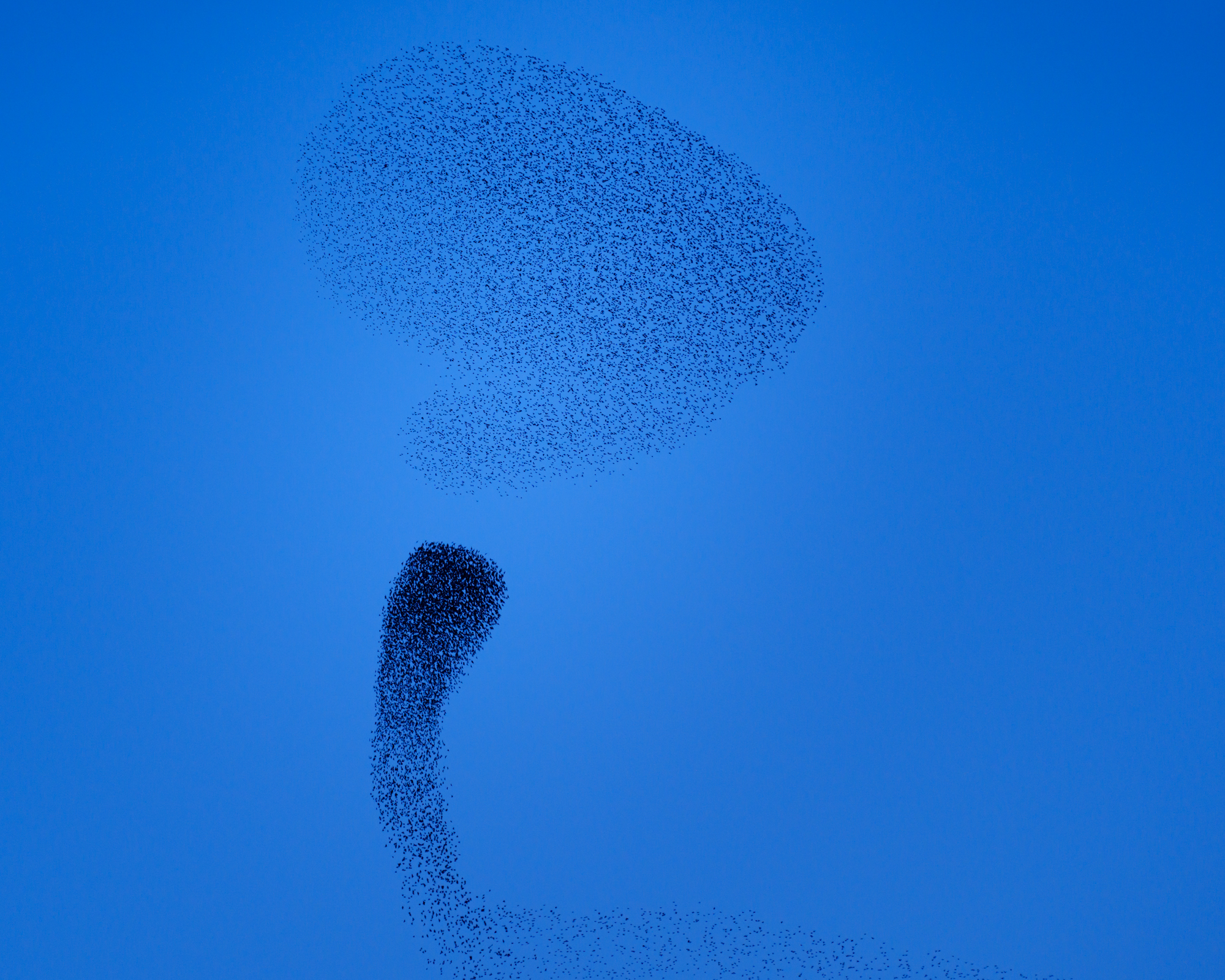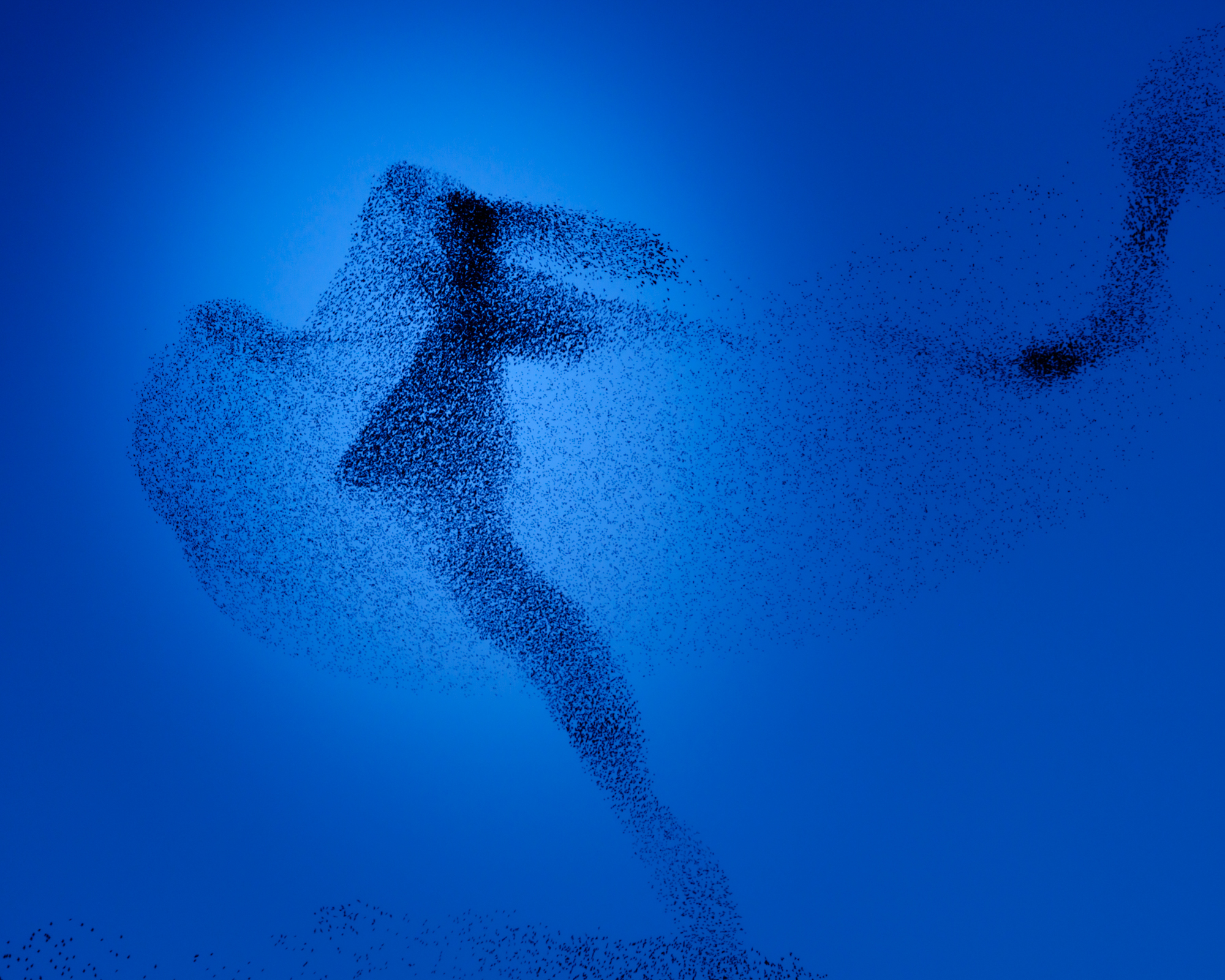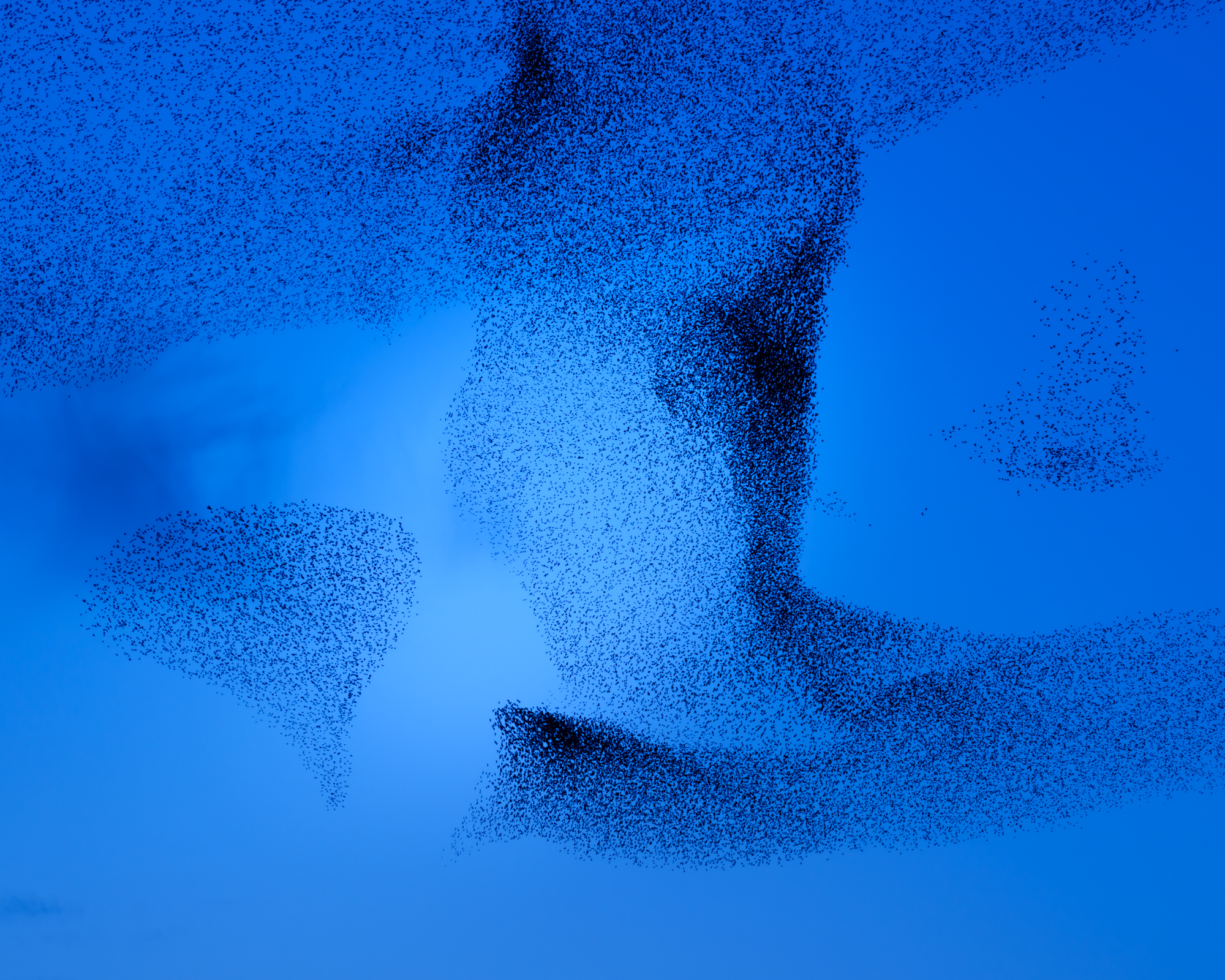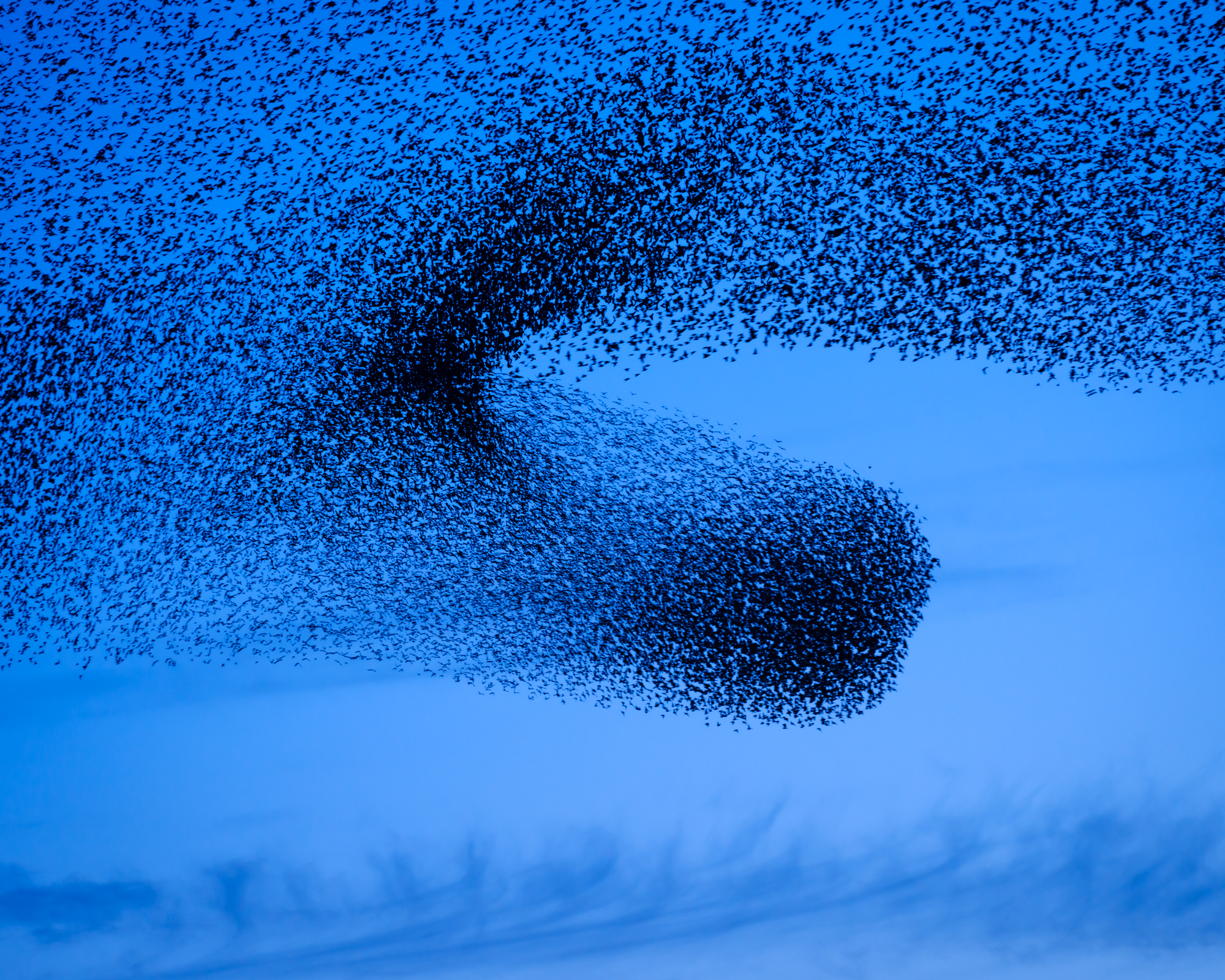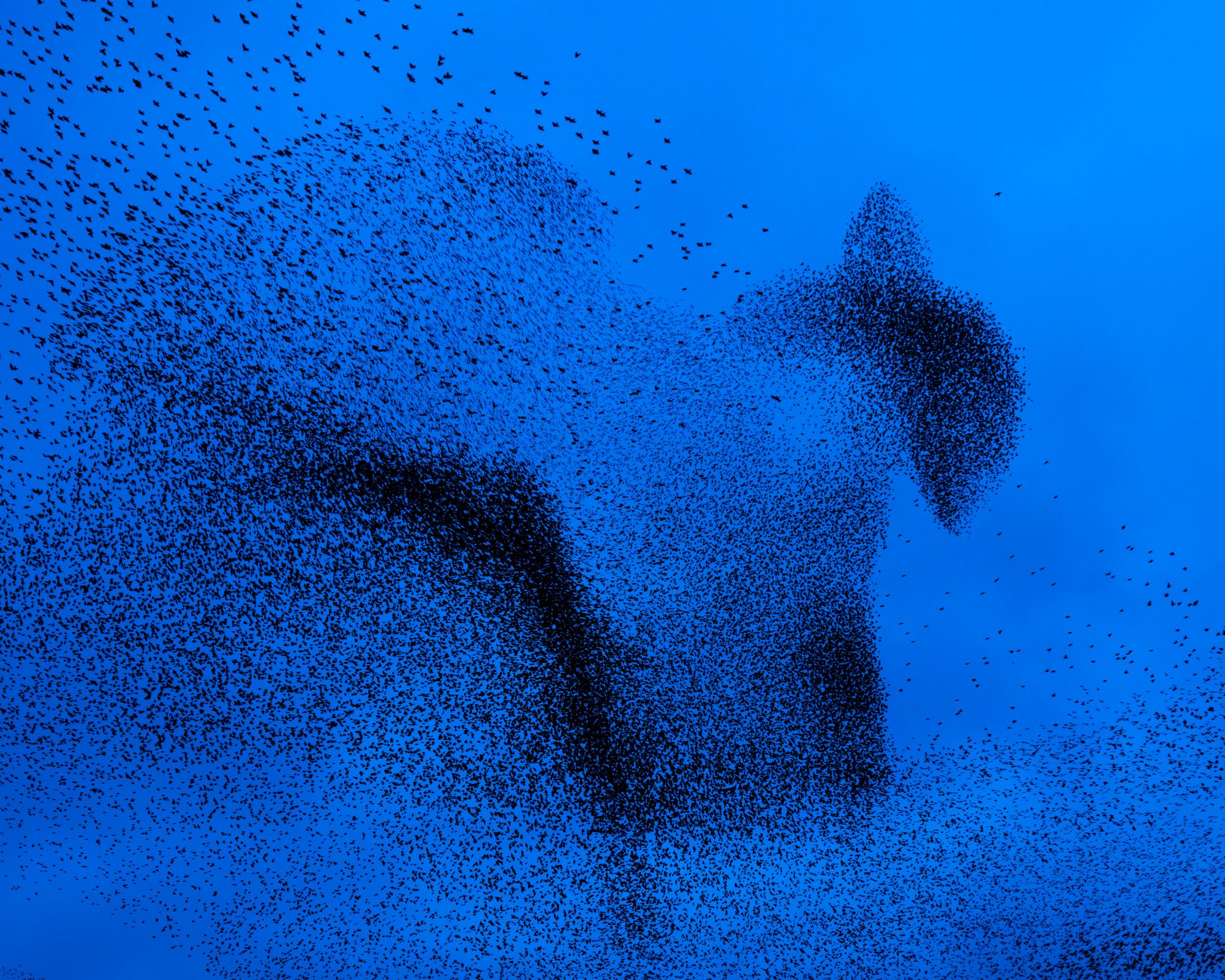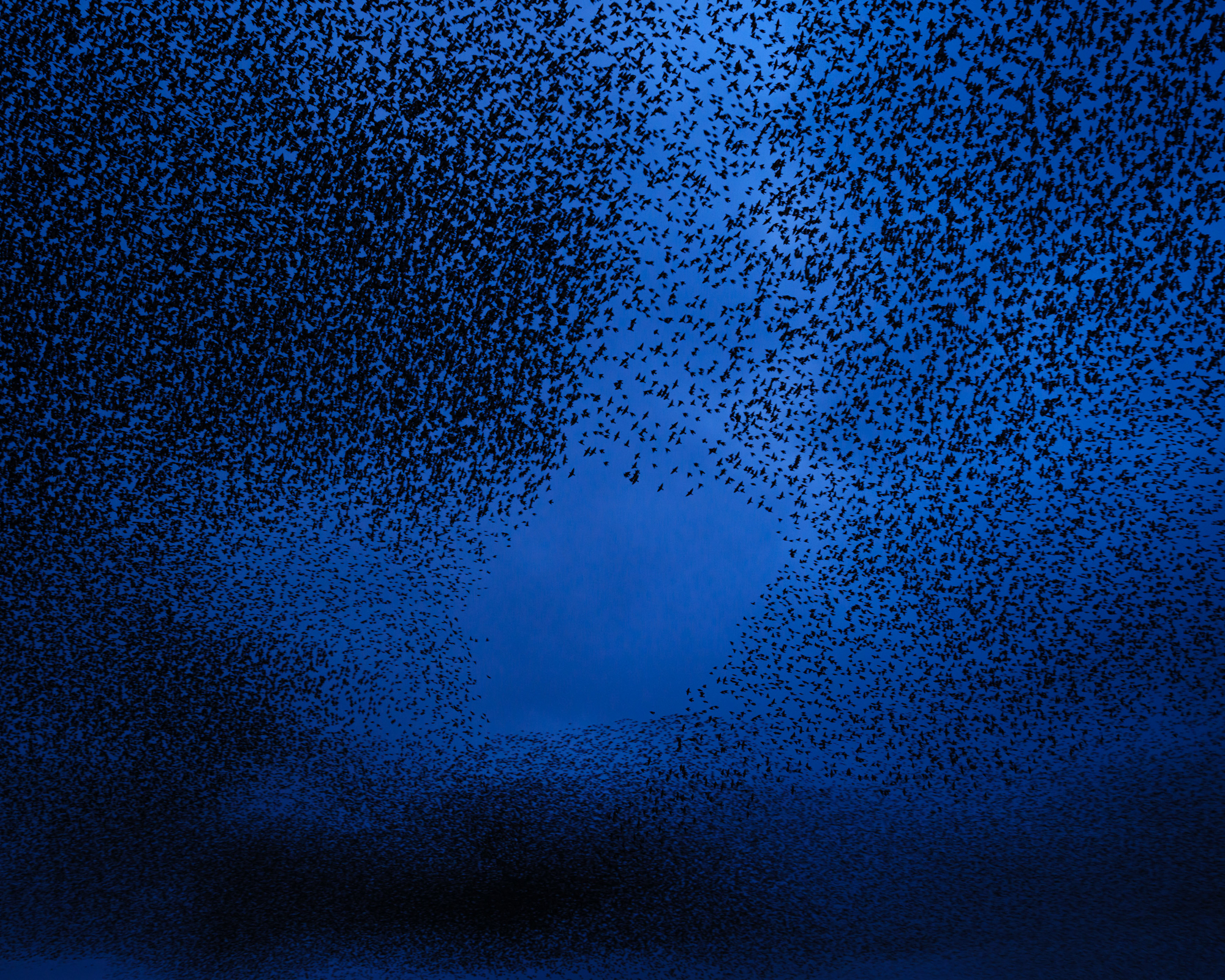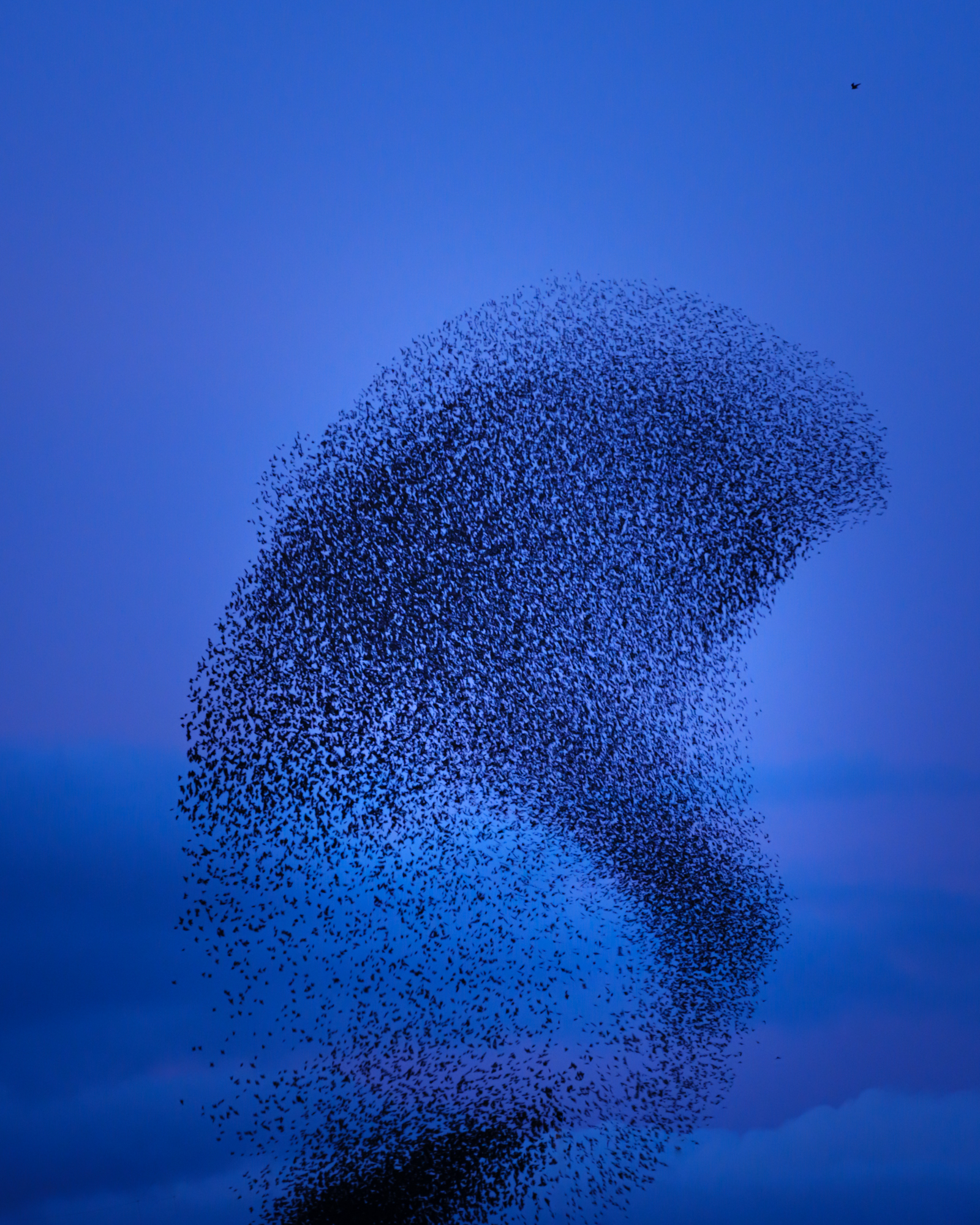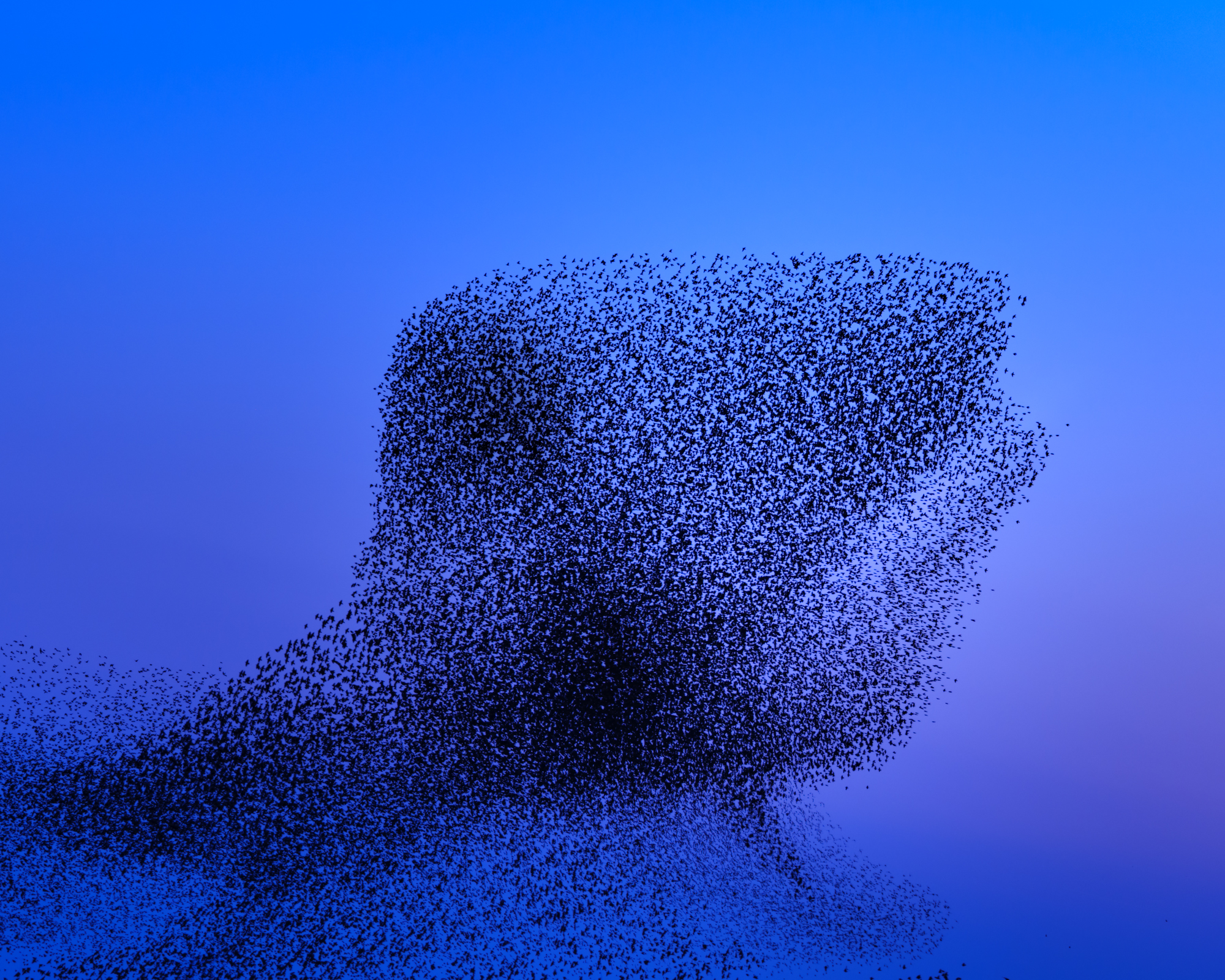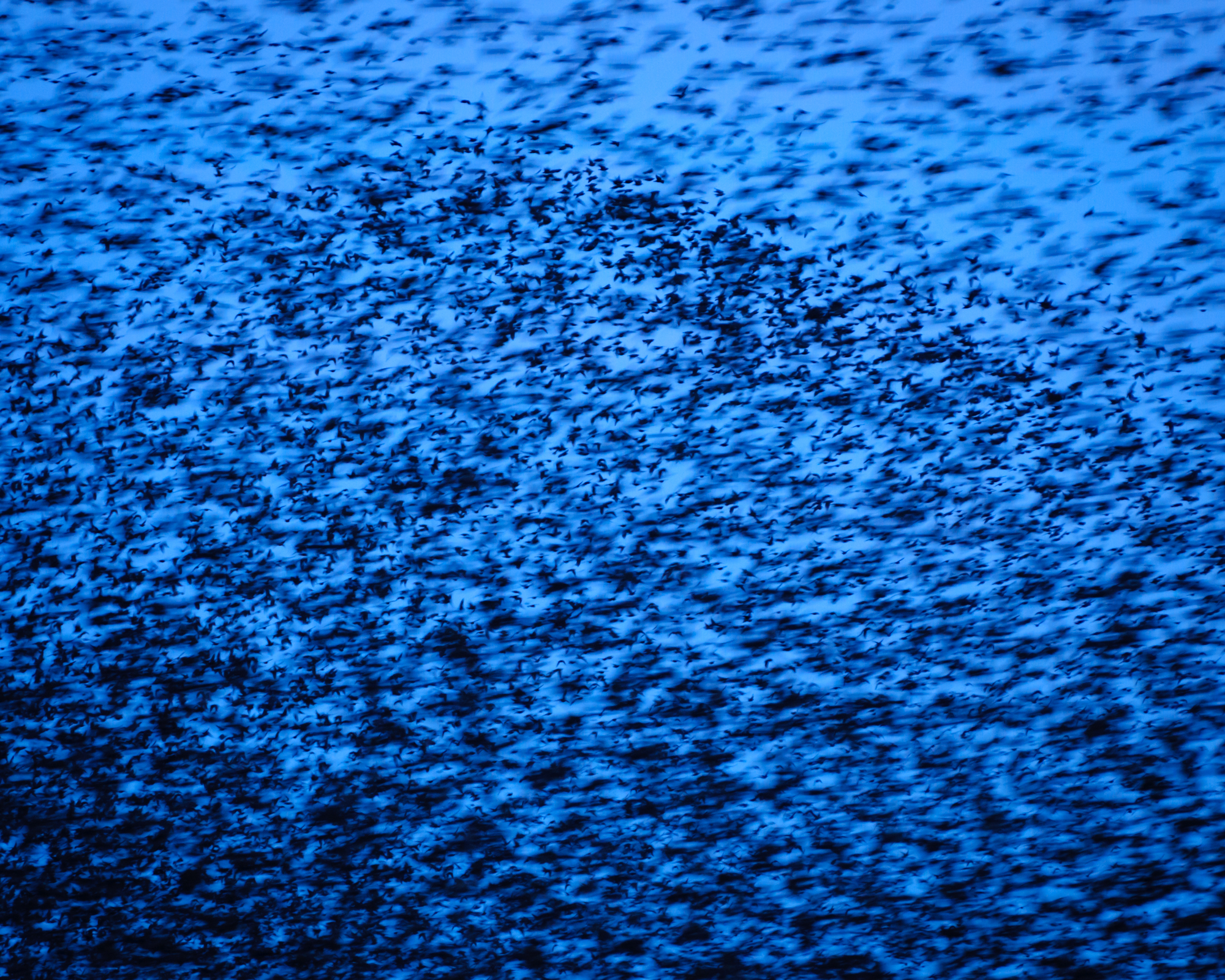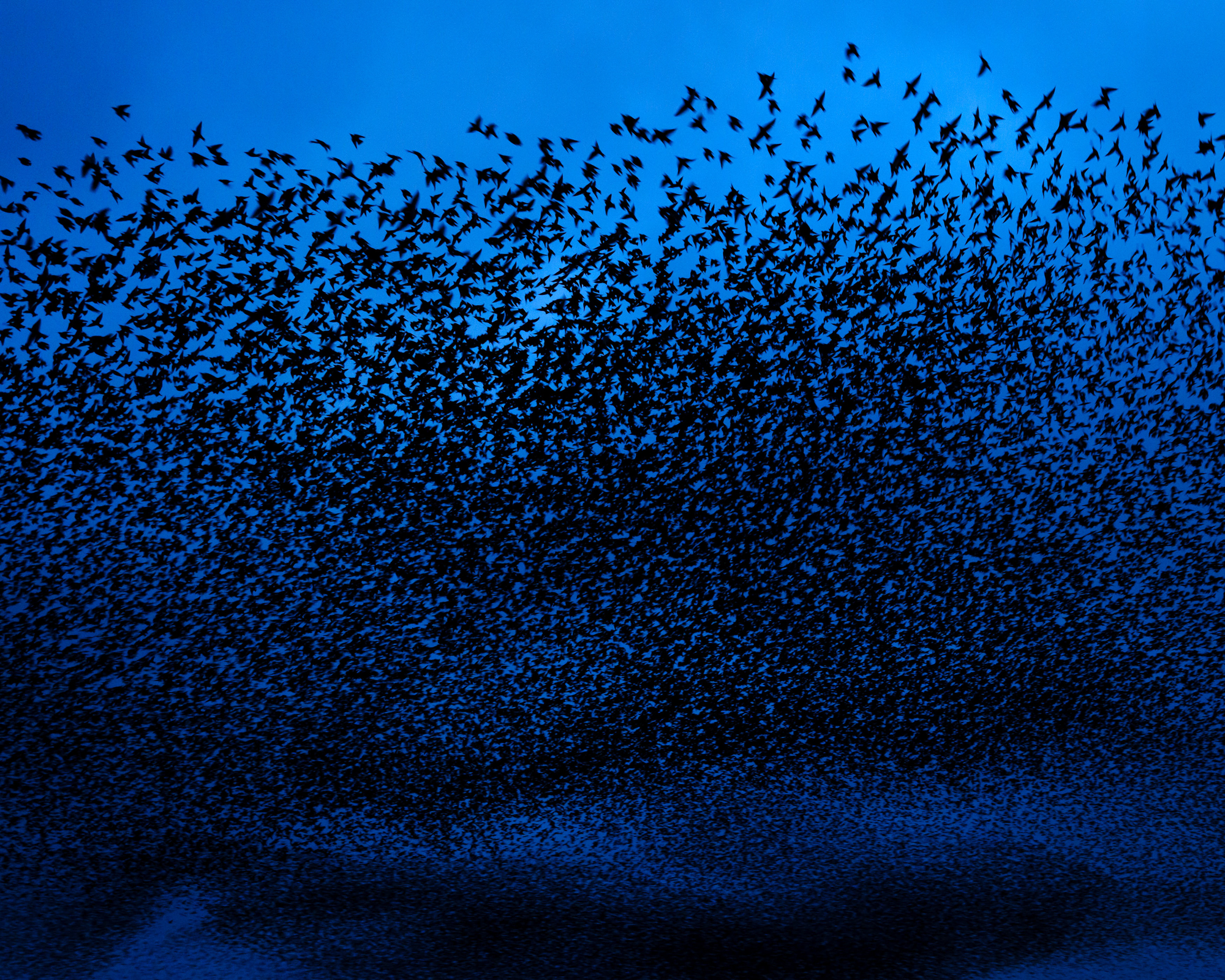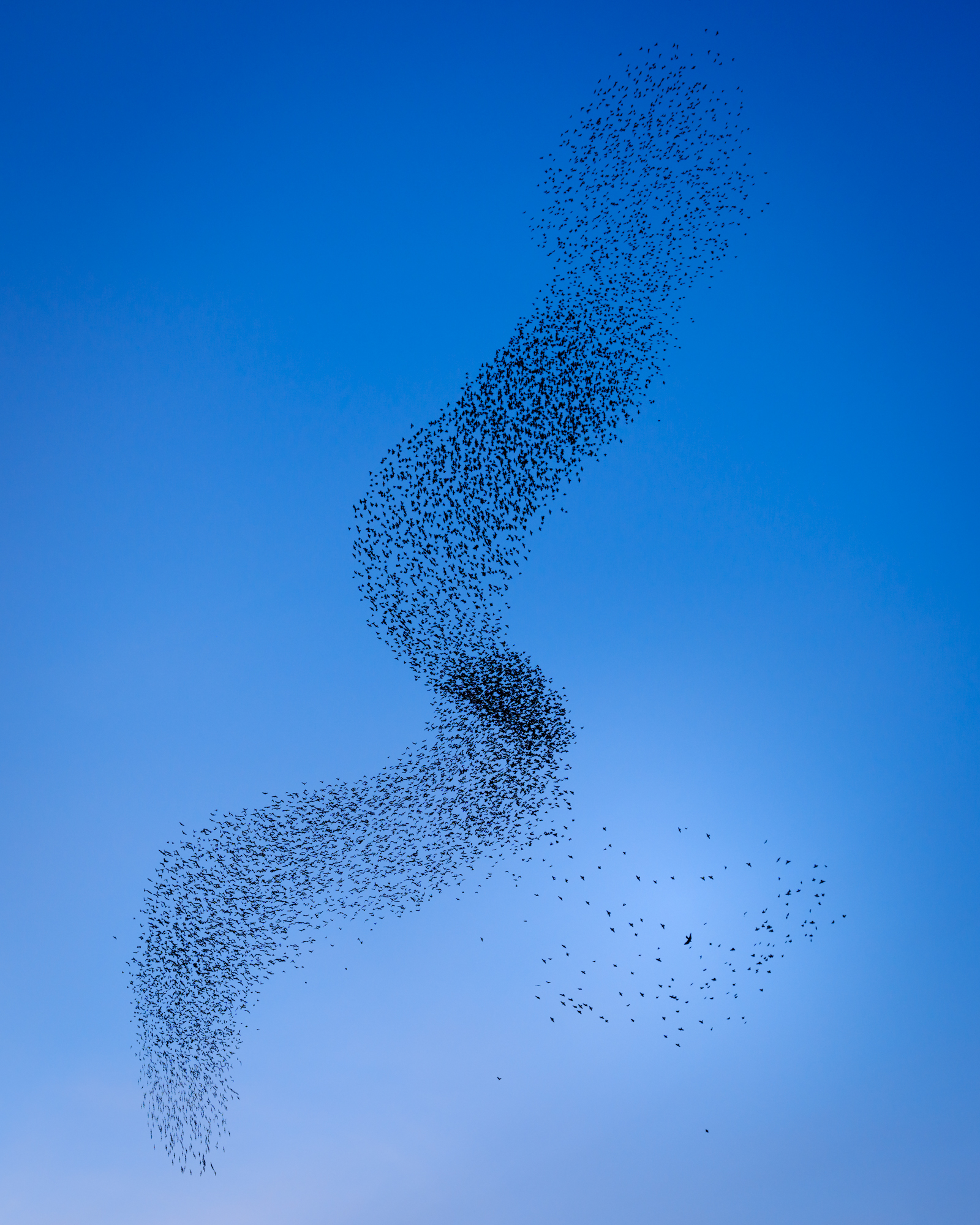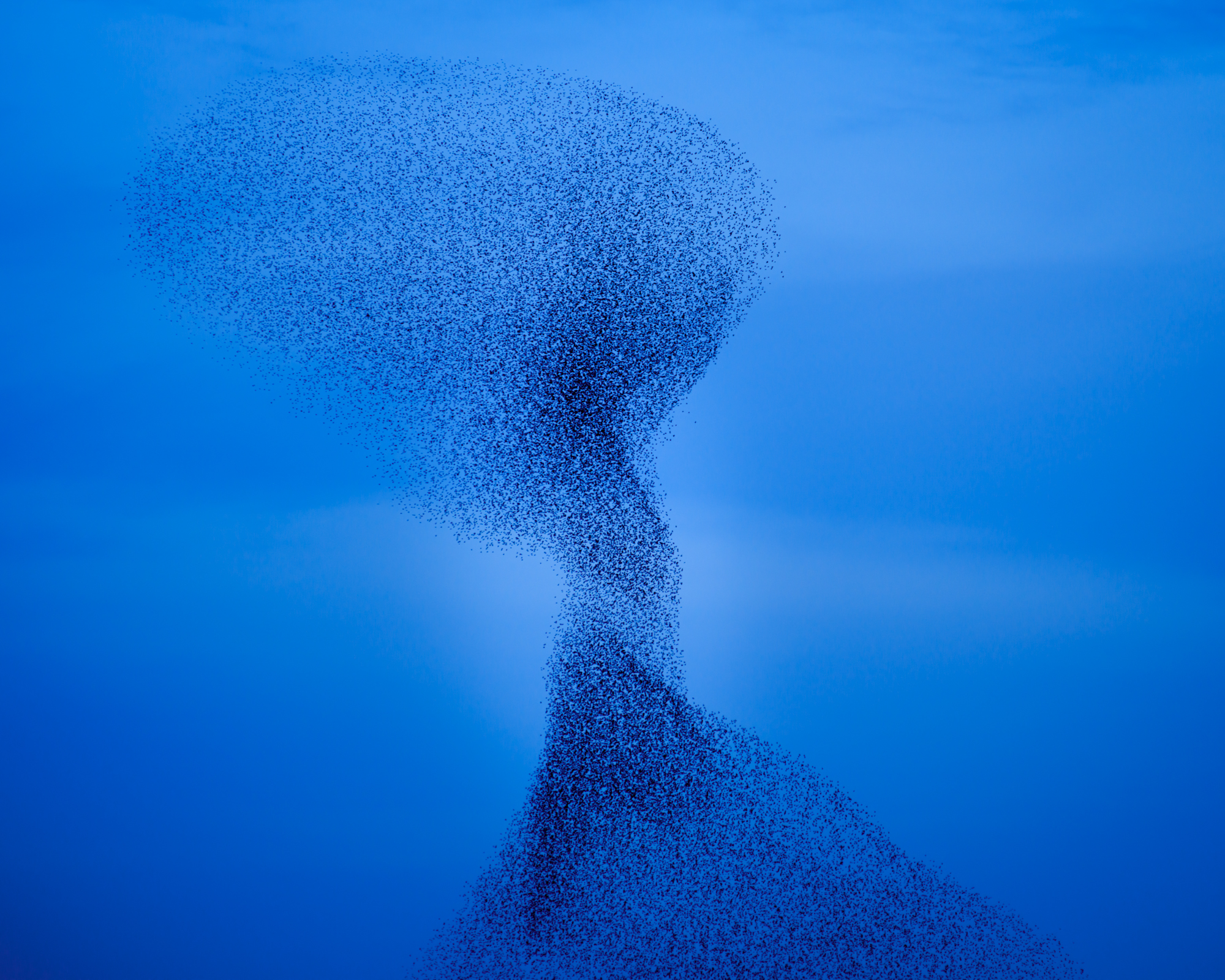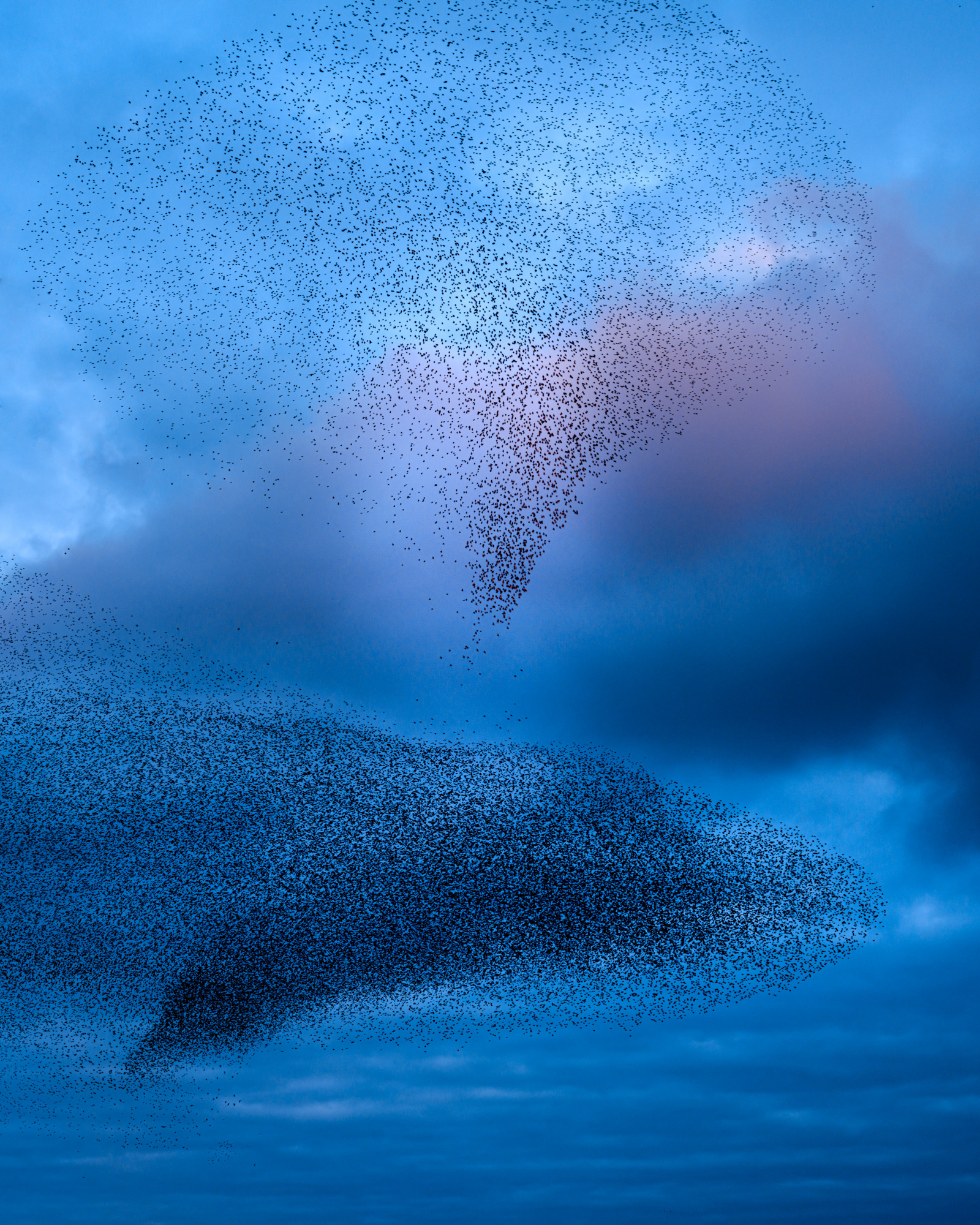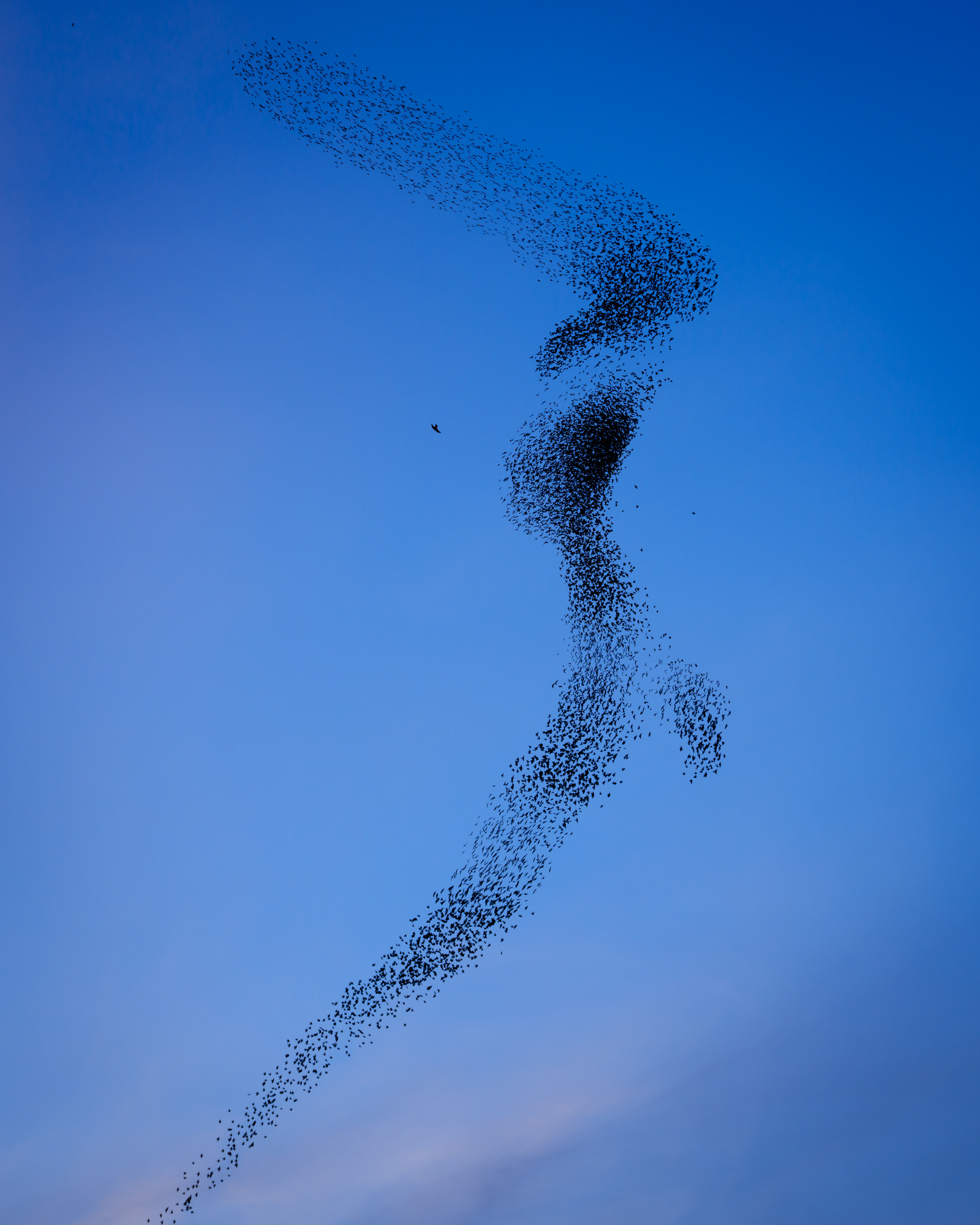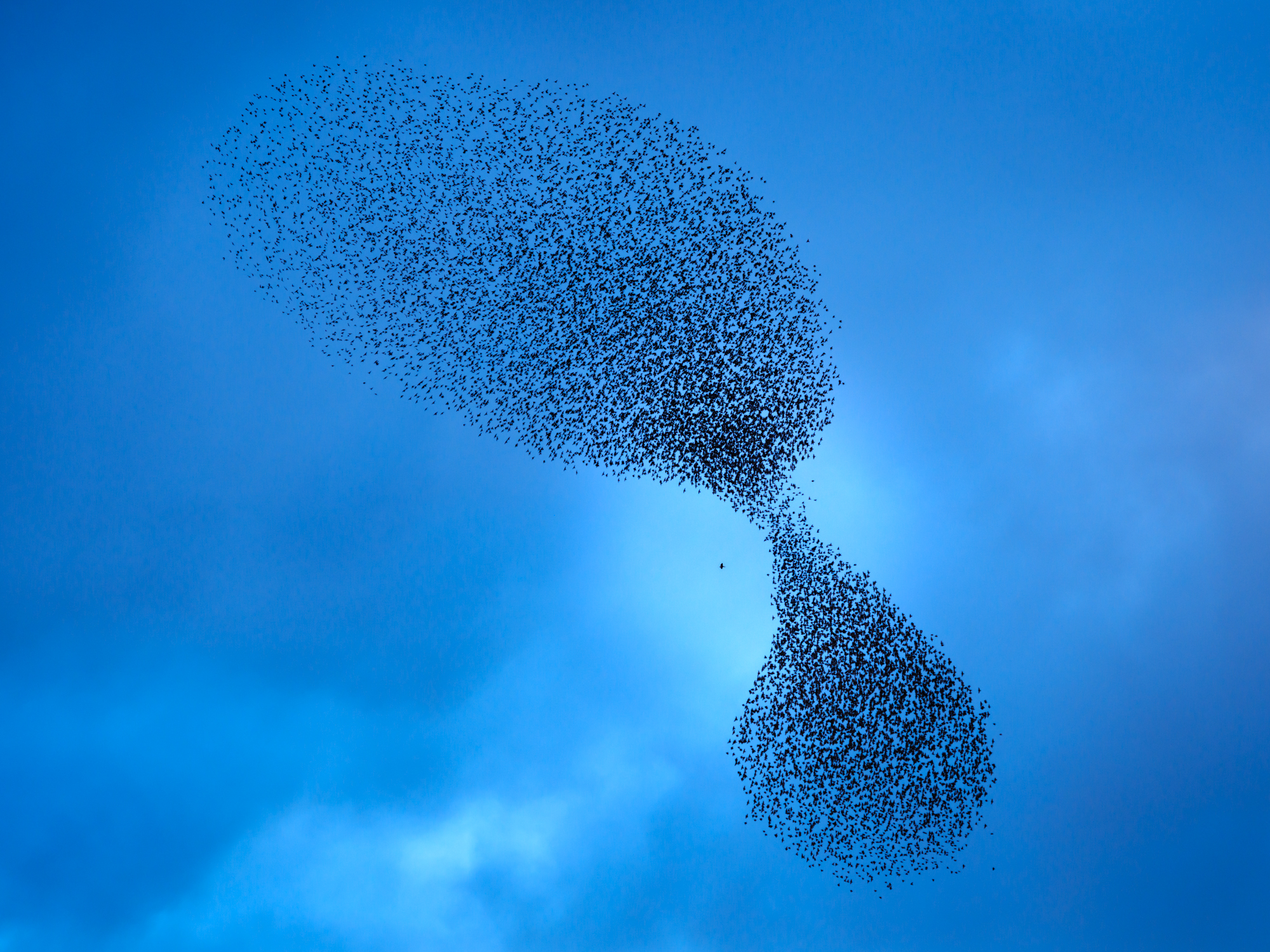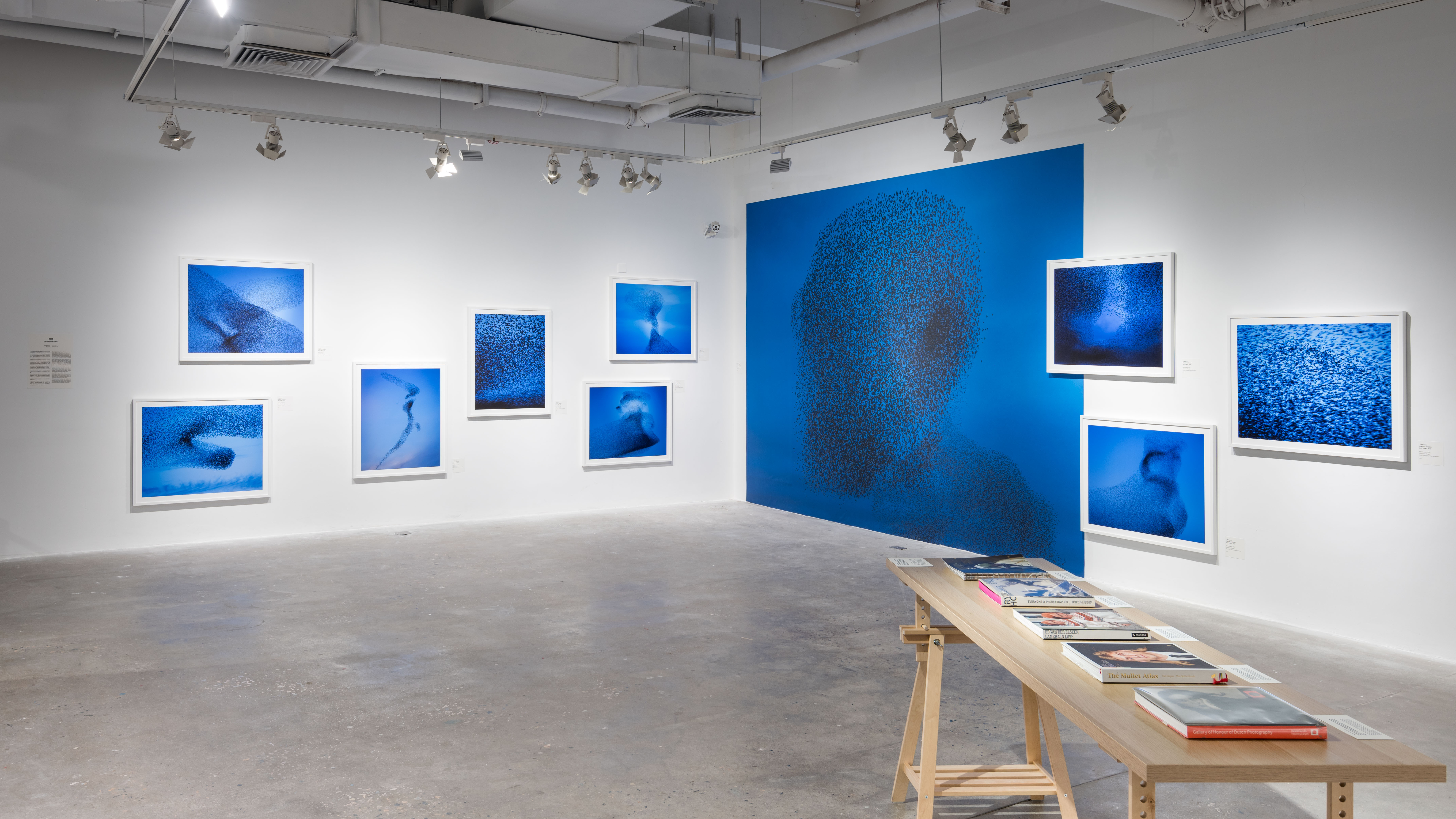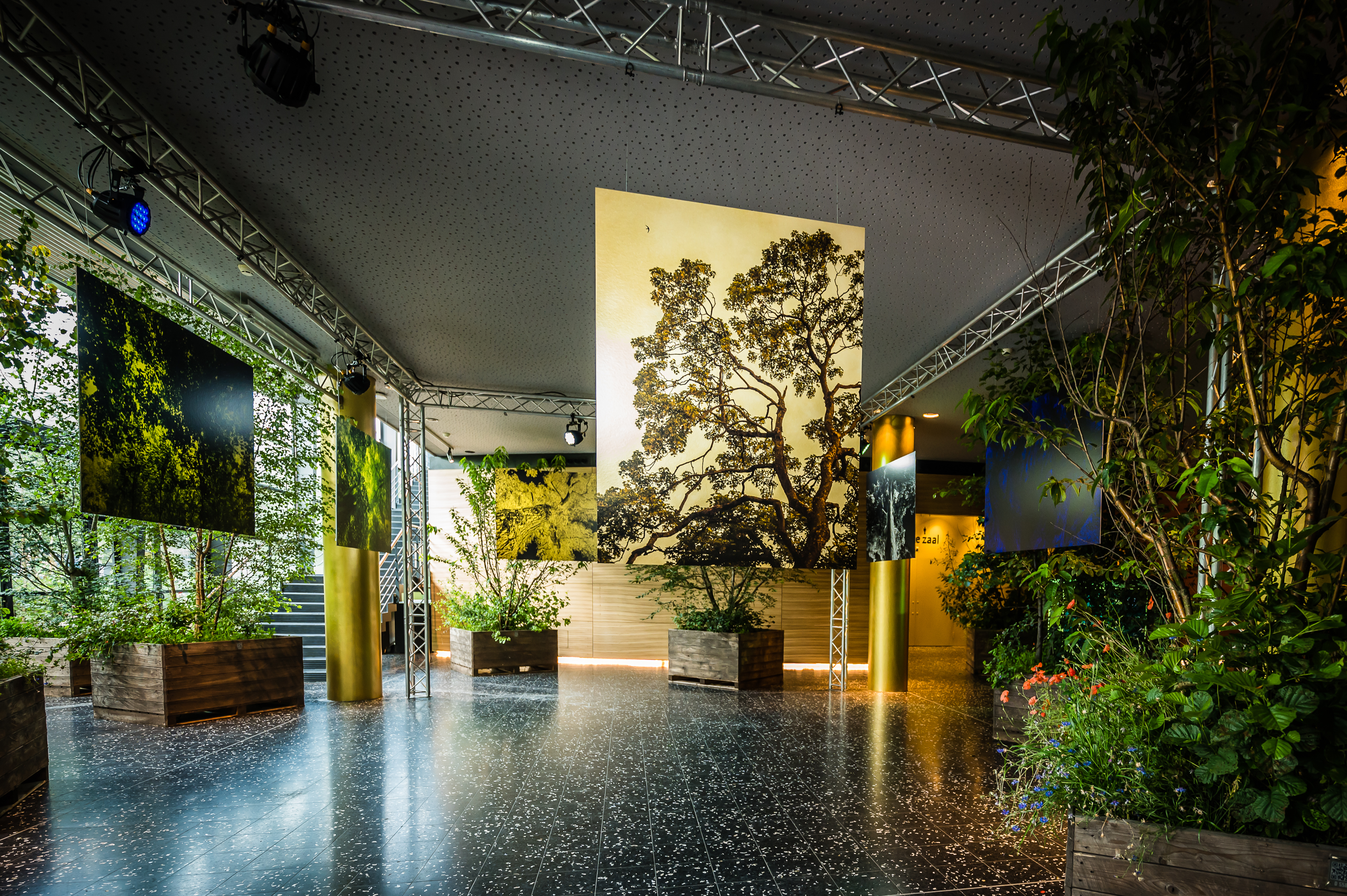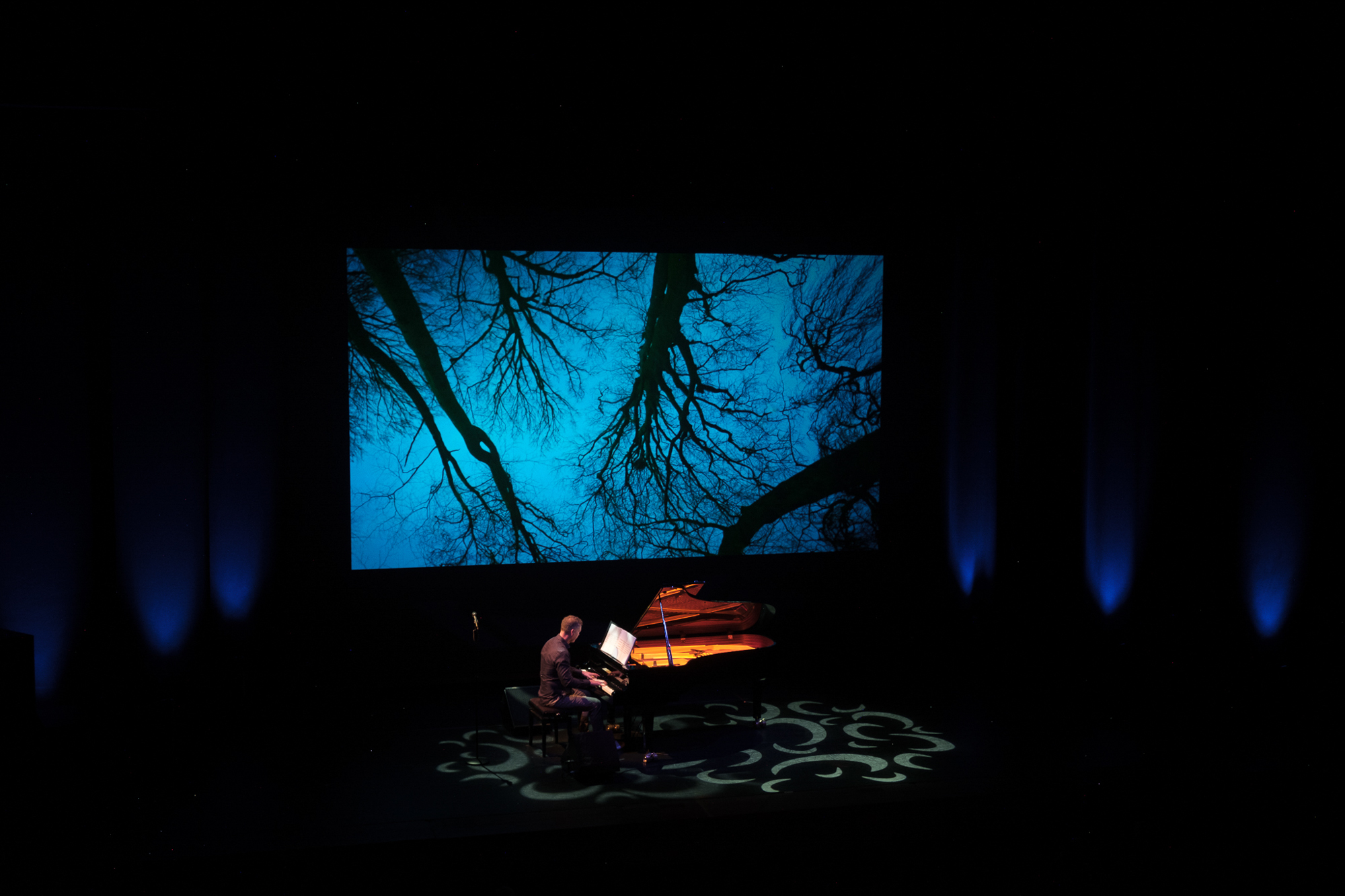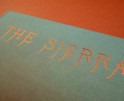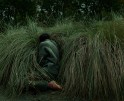New England Portfolio Review: Johannes Bosgra: Murmurations
Today, we are continuing to look at the work of artists with whom I met at this year’s New England Portfolio Review, hosted by the Griffin Museum and the Photographic Resource Center.. Up next is Johannes Bosgra.
Johannes Bosgra (NL, 1979) is a Dutch visual artist working in photography and video. His main inspiration is contemporary classical music. When he sees a landscape, he hears music in his head and vice versa; they flow into each other. In collaboration with composers and musicians such as Philip Glass, Bosgra creates video installations combining classical music, depicting minimalist landscapes, birds and other natural forms. And he plays piano himself. His work is often projected at live concerts.
“The landscape is my muse and my muse is dying. My work addresses the increasing disconnect between the appreciation people have for nature and the political support for its preservation.”
Bosgra created two videoworks for composer Philip Glass and pianist Feico Deutekom, the videoworks were part of an album concert tour in Dutch concert halls, a.o. De Melkweg and De Meervaart in Amsterdam. A minimal seascape from the Stripes series is used as album art on the album. In 2021 he created the videowork Verklärte Nacht, that premiered at Museum Voorlinden in Wassenaar (NL).
With his series Murmurations Johannes Bosgra has received international recognition with exhibitions at Three Shadows Photography Center Beijing, Rotterdam Photo, Head on Photo Festival Sydney, Shanghai Center of Photography, Singapore International Photo Festival, Prix de la Photographie Paris, Three Shadows Photography Center Xiamen, Goethe Institut Hong Kong, San Francisco Bay Month of Photography among others.
Bosgra has exhibited and performed his works internationally, notably at Museum Voorlinden in Wassenaar (NL), New World Symphony Hall in Miami, concert hall De Doelen in Rotterdam, ACCI Gallery in Berkeley, Muziekgebouw aan ‘t IJ in Amsterdam, Tonhalle in Düsseldorf. His series Trees by Bosgra was on view at solo exhibitions at the art route Open Stal, tower castle De Schierstins, Park Vijversburg and theatre de Harmonie in NL.
Johannes Bosgra is selected as FRESH EYES European Emerging Talent 2020 and GUP New Dutch Photography Talent 2020. Among his other awards are the Prix de la Photographie Paris and International Photography Awards.
Bosgra was president of the classical music festival Hortus Festival and has worked at the North Netherlands Symphony Orchestra.
Murmurations
Murmurations gives starling birds a voice. The voice of death. Since 1990, the number of starlings has decreased by 75 million in Europe. Murmurations is a requiem mass for the birds, as a symbol of our declining biodiversity.
A large swarm of one million starlings flit rhythmically across a deep blue sky, silhouetted like tiny black specks in musical motion at a nature reserve close to Bosgra’s home in the Netherlands. The starlings fly in swooping, intricately coordinated patterns and form abstract landscapes in the sky in a sublime musical rhythm.
Utterly mesmerized by the unfolding choreography, Bosgra did not seek to merely document the behavior of the swarms but to render their ballet in his own minimalist style. In the abstract forms in the images, Bosgra emphasizes the essence of the rhythm and flowing energy of the murmurations of starlings. By pointing the camera completely upward, he isolates the swarm from the ground and use the Yves Klein blue hour sky as a canvas. “When I see a landscape, I hear music in my head and vice versa; they flow into each other. Seeing the starlings dancing through the sky, changing direction at any moment to escape a falcon attack, I heard a pulsating quick-dance rhythm and totally engulfing ballet music reminiscent of Khatchaturian’s ‘Sabre Dance’.”
The landscape is Bosgra’s his muse and his muse is dying. Since his childhood, the Dutch landscape he once walked in as a little boy has seen a dramatic decrease in the number and variety of bird species. When he takes his son and daughter out into the field, he cannot step into the same nature he experienced as a child. In just one generation, an enormous amount of biodiversity has been lost.
Many people enjoy nature and nature photography but fail to see their behavior and political choices as part of the solution to protect it. For example many political groups have been outright hostile to the European Green Deal, which aims to reverse biodiversity loss and achieve carbon-neutrality. Bosgra wants to resolve the disconnect between the appreciation for nature and the necessary political and personal actions to conserve it.
As we lose ourselves in the hypnotic dance of these avian performers, we cannot escape the bittersweet truth that their numbers dwindle, their melodies fading into silence. Murmurations is a haunting clarion call, urging us to awaken from our dream-like disconnect and take decisive action to protect the natural world before it slips forever from our grasp.
Daniel George: When did you start paying attention to these flocks of starlings? At what point did you begin to see the potential for a body of photographic work?
Johannes Bosgra: The Murmurations series really came as a surprise. At the beginning of Covid, I couldn’t travel and visited a nature reserve close to my home in the Netherlands. To my delight there was an unusually large swooping mass of hundreds of thousands of starlings giving an aerial display. It was breathtaking. At first I just wanted to capture this beautiful ballet in the sky for myself. I rarely photograph just birds or other animals and usually focus on landscapes. But as I was editing the images with these mesmerizing abstract forms, I saw the potential for a series and decided to go back every day. After researching their behaviour, I learned that starlings gather just before dusk at their sleeping site. So I went there every evening to see where the starlings were flying to and tried to position myself exactly below the largest flocks to capture different forms every night.
DG: Here in the United States, starlings are viewed as a pest—as they are an invasive species. So for me, it’s intriguing to look at them in this work and consider them as an environmental bellwether, or a “celebration of biodiversity.” How do you feel that these images contribute to a conversation on preserving and improving the natural environment?
JB: In North America it is properly called the European starling. It has always been one of the most common native birds in Europe. But there are now 40-50% fewer starlings than 30 years ago, when I as a young boy loved to wander around in the Dutch landscape. I cannot step into the same biodiverse landscape with my children as my father did with me. The landscape is my muse, but my muse is dying. Because of industrial agriculture, the countryside has become a green desert of monocultures without soil life and a water level that is too low. A young meadow bird needs a thousand insects a day, but there just aren’t any! In just one generation, an enormous amount of biodiversity has been lost. The large flocks of starlings you can see in the north of the Netherlands today can only live here because nature conservation efforts have been so successful in protecting and creating wetlands. Enjoying nature has become very popular since COVID. But when I talk to people watching the starlings dance, the disconnect is huge. They love nature but don’t acknowledge that nature conservation is key to be able to keep enjoying this . And their political vote goes to the exact opposite: populist political parties that are anti-science, anti-nature conservation and deny climate change. We now have a far-right government that has sharply reduced investments in nature conservation and is pro industrial farming. With my work I want to draw attention to this important disconnect. I don’t do that by showing oil-soaked birds. That doesn’t fit who I am. With my Murmurations I show the public the mesmerizing beauty of this explosion of biodiversity in the sky. I want to take people into my ideal world, a meditative sublime environment that touches them. That is why I print my work large and project it in large form in concert halls and on buildings. To immerse people in this tranquility and ofcourse inform them on the fragility of it all. Murmurations is a requiem mass for the birds, as a symbol of our declining biodiversity.
DG: In your statement, you mention the deliberate choice to make these images during the “Yves Klein blue hour.” Why did you feel it was important to do this, and to give your photographs this cool visual language? What does that all mean to you?
JB: Blue holds a special place in my heart, as you can see in more of my work. I can lose myself in the intense blues of Cathedra by Barnett Newman in the Stedelijk Museum, an intriguing colorfield painting with 50 liters of blue paint. The starlings perform their dance only around sunset, just before resting. While editing my work the first time, I was immediately drawn to the few images I made after sunset, during the blue hour. Swarms of starlings flit rhytmicaly across a deep Yves Klein blue sky in these images, silhouetted like tiny black specks in musical motion. Almost like abstract japanese ink drawings, tranquil but rich because of the deep blue background. In my work I often use abstraction and monochromatic colours to find a minimalist aesthetic that resonates with me in a meditative way. So these images were perfect for that. The next evening I positioned myself under the flock and pointed my medium format camera completely upward, to isolate the swarm forms from the landscape and use the blue sky as a minimalist canvas. And I kept going on clear sky days, to create these minimalist blue abstractions of the dancing starlings.
DG: In your photographic work, you tend to approach the landscape in a simplified, abstract visual manner. What has led you, and continues to motivate this sort of interpretation of the environment?
JB: I adore minimal music and art. And the muted meditative Japanese view on aesthetics, wabi-sabi. The acceptance and appreciation of transience and imperfection in Japan, leads to an introverted aesthetic that represents how I would like the world to be. Repetition and simplifying in form and colour, reveals the soul and essence of a vulnerable landscape. To me, and hopefully many more.
DG: In your artist bio, you mention that your main source of inspiration is classical music. And in your artist statement you white about hearing music. Would you elaborate on that synesthetic connection with these photographs?
JB: When I sees a landscape, I hear music in my head and vice versa; they flow into each other. To me, music and image originate from the same source. They are just different mediums of the same energy. Seeing the starlings dancing through the sky, changing direction at any moment to escape a falcon attack, I heard a pulsating quick-dance rhythm and totally engulfing ballet music reminiscent of Khatchaturian’s ‘Sabre Dance’. But at other times the movement was more like the tranquill Preludes by Debussy. In the field I search for swarms that are musical. To me that happens when there is a clear rhythm and flowing energy to the swarm. For example when they fly up as a clearly defined group and change directions or create a whirlwind around me. This happens almost completely intuitively, they move very rapidly. Selecting/editing the sometimes more than 800 images of a night, I search for that perfect abstract form that has it all: musical tension, rhythm, intriguing abstract form and the perfect minimalist aesthetic. If I’m lucky there are one or two of those on an evening. Music informs me in creating the images, but I also use it in the exhibited works. I love to collaborate with composers and musicians to create video installations combined with classical music. Using my synesthesia I try to exactly match the rhythm and character of the musical piece with my images/videos. These works are often projected at live concerts. For example with the two video works I created for Philip Glass and the Dutch pianist Feico Deutekom, that were part of an album concert tour (video). With my series Murmurations I created the video work Requiem Avis (requiem for the birds), where I give the birds a voice. The voice of death. It was also projected at the Leeuwarden city hall at LUNA light festival. (video)
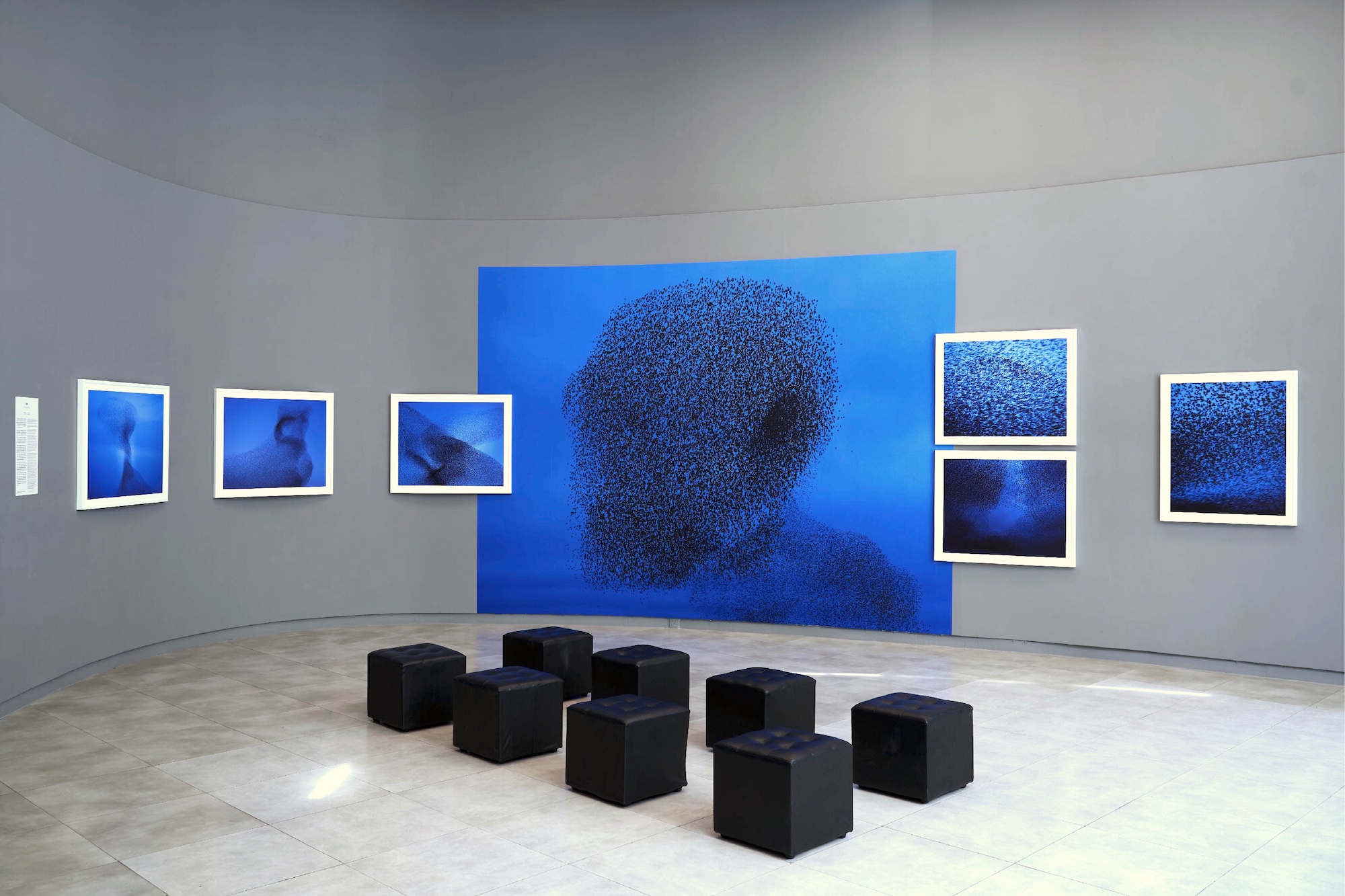
©Johannes Bosgra; Murmurations at exhibition NL Imagined in Shanghai Center of Photography (SCoP) (2022)
Posts on Lenscratch may not be reproduced without the permission of the Lenscratch staff and the photographer.
Recommended
-
Aaron Rothman: The SierraDecember 18th, 2025
-
Gadisse Lee: Self-PortraitsDecember 16th, 2025
-
Scott Offen: GraceDecember 12th, 2025
-
Izabella Demavlys: Without A Face | Richards Family PrizeDecember 11th, 2025
-
2025 What I’m Thankful For Exhibition: Part 2November 27th, 2025

